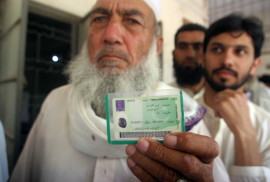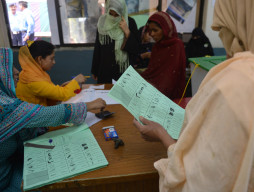

It was in the poorest districts that some of the highest turnouts were in evidence. Bahawalnagar, with a poverty rank of 37, saw all of its constituencies cross the 60 per cent mark. In fact, one constituency of the district, NA-191, was ahead of all constituencies of the country with a turnout of 84.8 per cent. Chitral, with a poverty rank of 61, had a voter turnout of 63.7 per cent. In rural Sindh, the highest turnout of 68.4 per cent was in NA-228 of Umerkot, followed by 67.5 per cent in NA-233 of Dadu. NA-267, Kachhi-Jhal Magsi, attracted 61.3 per cent of the registered voters. Both constituencies of Layyah, which are ranked 60 on the poverty scale, attracted turnouts of 67.6 and 68.1 per cent. All five constituencies of Muzzafargarh, ranked 90 at the bottom vis-a-vis poverty, showed a voter turnout of above 61 per cent.
The daily struggle for making ends meet occupies the poor the most. This is what economists call an opportunity or alternative cost for political participation. Their experiences inform economists about the hollowness of the political sloganeering to reduce poverty and unemployment. How is it that the highest turnouts have occurred in the poorest constituencies? Poverty is strongly correlated with the poor state of education and health. Many of these constituencies lie far away from the “media land.” Awareness, therefore, cannot explain much in this regard. Mobilisation by political parties through mass work can bring the poor out. Other than some big jalsas by major parties, political work at the grassroots level has become a thing of the past. There was no Bhutto-style wave anyway, Imran Khan’s tsunami notwithstanding. Restrictions placed by the EC on serving food and transport should also have also reduced the turnout.
Many of these constituencies continue to suffer from the feudal stranglehold. In its worst form, the thana kachehry culture fertilises ghost turnouts. The EC has admitted that the turnout at some polling stations was more than 100 per cent. One will not be surprised if many such polling stations were located in the poverty-stricken, high-turnout constituencies. There is work cut out for the EC. After holding an election which, on the whole, was free of political and extra-political meddling, it has to find ways of delinking the electoral competition from the informal nexus between the political elite and the administration at the constituency level.
Published in The Express Tribune, May 17th, 2013.
COMMENTS (5)
Comments are moderated and generally will be posted if they are on-topic and not abusive.
For more information, please see our Comments FAQ



























1714024018-0/ModiLara-(1)1714024018-0-270x192.webp)










I want to ask the author where is he getting his statistics .I'am from Chitral and I can tell you the poverty rate is no where near 61% .Yes people earn less that's because they live off their land and many have little value for money .Children both male and female are sent to schools and it has one the highest literacy rates in KPK and now we are aiming for a 100% enrolment rate.So please people in Chitral came out to vote because it was their duty and please unlike the rest of you blokes were not chained by feudalism .So please don't try to suggest that people in Chitral voted because their poor.
@Nadir: Sir, thanks for telling it like it is. In addition the election and turnout has not been consistent. In Balochistan there are BA seats where PML-N candidate has been elected with only 500 odd votes! Balochistan being the poorest province and the turnout in most rural areas has been scarce. Regards, M
bottomline, massive rigging and most politicised electiond ever/
What a condescending piece of writing. Why does it surprise you that the poor came out to vote? Isnt it always the peasants, workers and farmers that strive for their rights while the rich and affluent have been supporting dictators throughout Pakistan's history.
Sir, the EC has NOT "admitted that the turnout at some polling stations was more than 100 per cent.". In fact, they have issued clarifications saying FAFEN had their numbers wrong.
FAFEN took polling counts from Form-XIV at polling stations and calculated turnout percentages using registered voter data for said polling stations. They obtained the data from the ECP's website from a document called 'polling scheme'. The numbers there were erroneous and possibly from an older voting list.
The ECP - and various ROs - have issued clarifications with real registered voter counts and showed that there was no polling station with more than 100% turnout.
Factcheckers should be employed before opeds can be published.